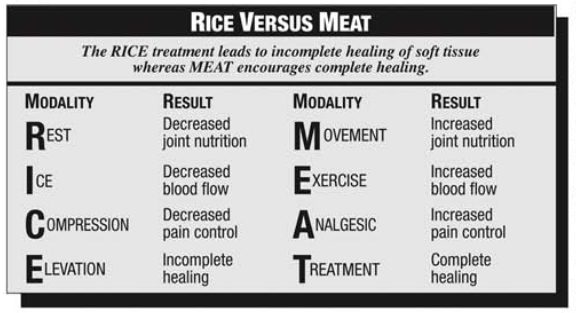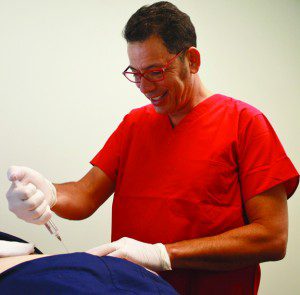By Caring Medical and Rehabilitation Services
Have you sustained an injury due to sports or overuse? Did you immediately reach for a bag of ice only to find that weeks later you are still icing the injury but not feeling better? The reason is simple. In addition to other steps of the well-known RICE protocol, ice is not an effective method for resolving most injuries. Let’s explore the RICE protocol a little further and its more effective alternative: the MEAT protocol.
 The RICE protocol
The RICE protocol
RICE stands for Rest, Ice, Compression and Elevation. Occasionally, “P” is added to the protocol. It stands for Protection, and consists of bracing or taping the area. A key premise of the RICE treatment is that the swelling that accompanies an injury is harmful to the tissue and, therefore, it is designed to decrease circulation to the area. Understanding the difference between ligament and muscle tissue is crucial to understanding when RICE is appropriate for an injury.
One of the most common joint injuries revolves around the strain or sprain of ligaments and tendons. Ligament sprains, for instance, are often accompanied by quite a bit of painful swelling. Ligaments are the small and mighty tissues that hold our joints together. They are made of collagen, one of the strongest substances in the body. Due to their poor blood supply, ligament injuries are subject to incomplete healing and are the cause of most chronic sports injuries and pain. On the contrary, muscles heal quickly due to their excellent blood supply and rarely cause a long-term problem. While the accumulation of fluids, or edema, can in fact be harmful to muscles in the form of compartment syndrome, this does not apply to ligament and tendon injuries.
Compartment syndrome occurs when swelling due to an injury places pressure on the muscle tissue, which decreases circulation and healing, which causes further swelling due to fluid accumulation, which decreases healing even more. This vicious cycle can lead to permanent muscle, nerve or circulation damage, which is why the RICE treatment has become an established protocol for muscle injuries, however has been inappropriately applied to ligament injuries as well, which operate under an entirely different set of circumstances.
If the limited blood supply to the ligaments is cut off using the RICE method, the body’s ability to heal is compromised. Furthermore, the blood supply to the ligaments is the poorest at the point where the ligament attaches to the bone, called the fibro-osseous junction. This point is also the weak link in the ligament-bone complex, and the area most commonly injured during sports and is responsible for most lingering sports injuries.
The MEAT protocol, and why it promotes healing
The more conservative, and effective, treatment for joint injuries is the MEAT protocol (Movement, Exercise, Analgesics and Treatments). (See Figure 1.) While immobility is detrimental to soft tissue healing, movement is beneficial because it increases blood flow to the injured area by generating heat. This is why the application of heat is also recommended for ligament and tendon injuries. Gentle range-of-motion exercises also help improve blood flow to the injured area. Natural analgesics, such as proteolytic enzymes, decrease the painful swelling of soft-tissue injuries but do not stop the natural inflammatory reactions that lead to healing. Examples include bromelain (from pineapple), trypsin, chymotrypsin and papain (from papaya). Other options for pain control include pain relievers that are not synthetic anti-inflammatories, such as Tylenol (acetamino-phen). They help relieve pain without decreasing inflammation, a critical part of the soft-tissue healing process.

What about taking anti-inflammatories, such as ibuprofen?
Injuries need blood flow in order to repair fully. The use of anti-inflammatory medications can prevent the injury from fully healing, and allow the cycle of pain and increased pain medication to continue. For people looking to stop this vicious cycle, put down the ibuprofen and look to regenerative treatments to bring about joint rejuvenation and get you back to your active lifestyle.
Finding the right treatment for your injury
Treatments are called for in the MEAT protocol in order to increase blood flow and immune cell migration to the injured area that will assist ligament and tendon healing. Treatments can include physical therapy, massage, chiropractic care, ultrasound, and myofascial release. All improve blood flow and help soft tissue to heal. If the injury has not healed within six weeks, more aggressive treatments should be considered, including comprehensive Prolotherapy, a natural injection therapy. (See Figure 2.) For athletes and active people who are in season and cannot afford time off from their sport or busy schedule, this natural injection therapy is a great option for rejuvenating the painful joint and does not require the extensive downtime of the RICE protocol. In summary, the MEAT protocol is more effective and expedient than the RICE protocol when it comes to healing ligament and tendon injuries.
PROLOTHERAPY SPECIALISTS:
Ross A. Hauser, M.D.
Danielle R. Steilen, MMS, PA-C
Timothy L. Speciale, DO
(239) 303.4069 | www.CaringMedical.com
Check Also
Physical Therapy for the Brain
Have you noticed you have difficulty hearing your family and friends in a noisy restaurant? …
 South Florida Health and Wellness Magazine Health and Wellness Articles
South Florida Health and Wellness Magazine Health and Wellness Articles




